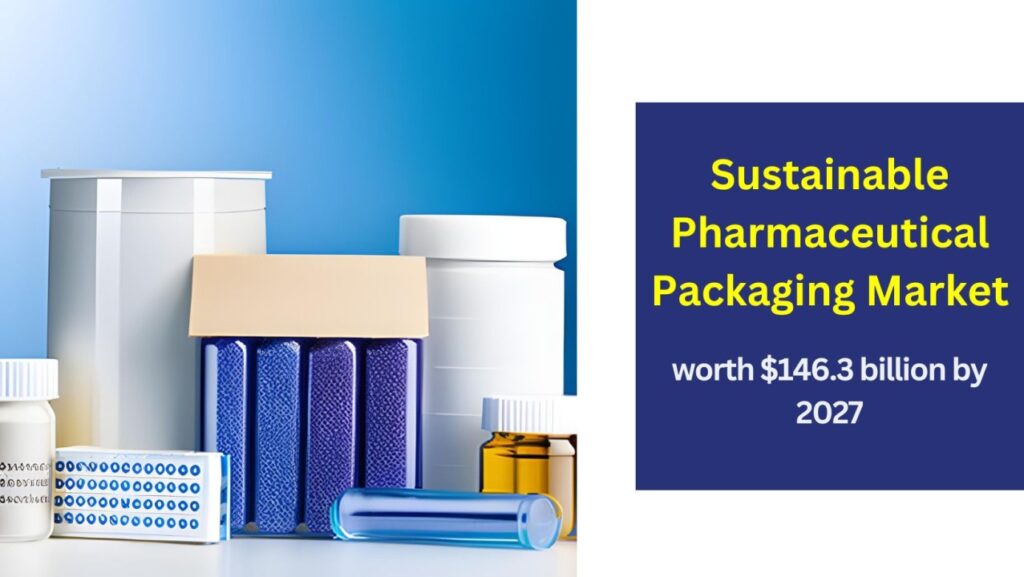Sustainable pharmaceutical packaging refers to the use of eco-friendly and environmentally responsible materials and practices in the packaging of pharmaceutical products. It aims to minimize the environmental impact of the pharmaceutical industry by reducing waste, promoting recyclability, and using biodegradable or compostable materials. Sustainable packaging solutions strive to balance the need for product protection and safety while ensuring reduced carbon footprint and overall environmental sustainability. The adoption of sustainable pharmaceutical packaging is driven by increasing environmental awareness, regulatory requirements, and the industry’s commitment to corporate social responsibility.
The global Sustainable Pharmaceutical Packaging Market size is projected to grow from USD 71.6 billion in 2022 to USD 146.3 billion by 2027, at a CAGR of 15.4%.

“Plastics segment amongst other raw material projected to grow at a highest CAGR”
The plastics segment, along with other raw materials, is forecasted to experience the highest compound annual growth rate (CAGR). Factors such as advancements in sustainable plastics, increasing demand for eco-friendly packaging, and rising awareness about environmental impact drive the growth of this segment. As the pharmaceutical industry emphasizes sustainability, the use of eco-friendly plastics and other raw materials in packaging is expected to surge, meeting both industry and consumer demands for greener solutions.
Download PDF Brochure: https://www.marketsandmarkets.com/pdfdownloadNew.asp?id=72534537
“Biodegradable Segment projected to grow at the highest CAGR”
The biodegradable segment is anticipated to register the highest compound annual growth rate (CAGR). The increasing demand for eco-friendly packaging solutions and growing environmental concerns drive the adoption of biodegradable materials in the pharmaceutical industry. As pharmaceutical companies prioritize sustainability, the biodegradable segment is expected to witness significant growth, offering environmentally responsible packaging alternatives for medicines and healthcare products.
“Based on packaging type, primary packaging is projected to register the highest CAGR”
Primary packaging in sustainable pharmaceutical packaging industry refers to the first layer of packaging that comes into direct contact with the drug product. The main goal is to provide protection and preservation of the product. Sustainable primary packaging materials aim to minimize environmental impact, reduce waste and conserve resources by using eco-friendly and biodegradable materials like paper, cellulose, or bioplastics. Additionally, pharmaceutical companies are adopting innovative packaging designs, such as lighter weight packaging and reducing the use of materials, to reduce waste and minimize their carbon footprint. The use of reusable and refillable packaging is also being explored as a way to reduce waste. Overall, sustainable primary packaging is a key aspect in the push towards a more environmentally responsible pharmaceutical industry.
“Asia Pacific is projected to grow the fastest in the sustainable pharmaceutical packaging market”
The Asia Pacific region is expected to experience the highest growth rate in the sustainable pharmaceutical packaging market. Factors such as increasing environmental awareness, stringent regulations, and rising demand for eco-friendly packaging solutions in the pharmaceutical industry contribute to this rapid expansion. As sustainability becomes a key focus for pharmaceutical companies and consumers, the adoption of eco-friendly packaging options is likely to accelerate in the Asia Pacific region.
South America is a region that is increasingly focused on sustainability and the pharmaceutical industry is no exception. Pharmaceutical companies in South America are exploring innovative ways to reduce their environmental footprint and improve sustainability in their packaging. In recent years, there has been a growing interest in eco-friendly packaging options such as biodegradable plastics, recyclable plastics, paper-based packaging, and reusable containers. Additionally, the regulatory landscape in South America is becoming more stringent with regards to environmental protection and sustainability.
Request for Bundle Report at https://www.marketsandmarkets.com/RequestBundleReport.asp?id=72534537
The key players are SCHOTT AG (Germany), Amcor PLC (Switzerland), AptarGroup S.A.,Inc (US), West Pharmaceutical Services, Inc. (US), Berry Global, Inc. (US), Gerresheimer AG (Germany), Catalent Pharma Solutions ,Inc (US), WestRock Company (US) and others.
Recent Developments
- In September 2022, Aptar Pharma launched an innovative dispensing solution that is mono-material and fully recyclable when paired with a PE or PET bottle. It is suitable for a range of viscosities, customizable with two dosage options and two neck size options, and is available in a variety of colors with its unique, three-part design.
- In September 2022, Berry Global Group, Inc. announced a collaboration with Mars Inc. to launch its popular pantry-sized treats in polyethylene terephthalate (PET) jars that have been optimized by including 15% recycled plastic content, i.e., post-consumer resin (PCR).
- In November 2022, Aptar Pharma announced its collaboration with TFF Pharmaceuticals. This collaboration is aimed at developing and testing the administration of dry powder vaccines utilizing TFF Pharmaceutical’s Thin Film Freezing technology and Aptar Pharma’s proprietary intranasal Unidose (UDS) powder nasal spray system.
- In June 2022, WestRock Company announced a partnership with Recipe Unlimited to introduce a line of recyclable paperboard packaging, with the goal of keeping 31 million plastic bottles out of Canada’s landfills annually.